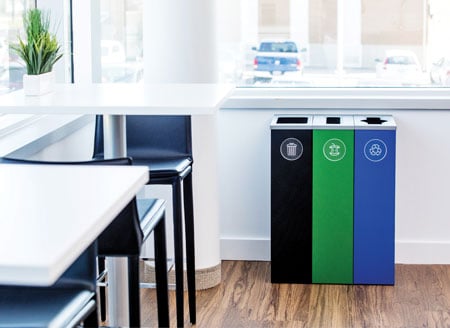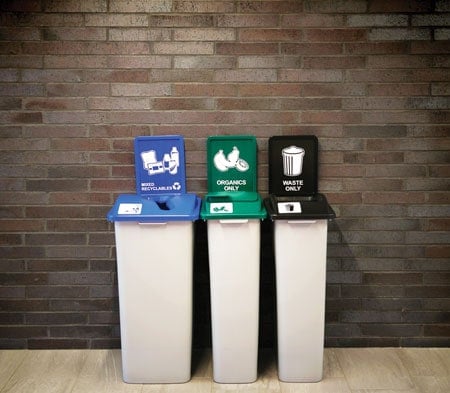Having a strong waste diversion program within your organization demonstrates commitment to sustainability and conservation of valuable resources. Following best practices when implementing a recycling program will make a world of difference in maximizing the diversion rate.
By Lindsay Jones
From private businesses, to university institutions and municipalities, waste reduction is more important than ever, with many organizations even adopting zero waste goals and strategies. Having effective recycling stations is the first step in supporting these waste reduction goals and minimizing waste sent to the landfill. Incorporating best practices regarding colors, signage, restrictive openings and placement when deploying containers will ensure maximum recycling rates.
Having a successful waste diversion program requires much more than simply placing recycling containers within your building and hoping for the best. There are key design and infrastructure elements influencing user behavior and ultimately, the level of program success. These best practices will encourage use of containers, as well as have a positive impact on contamination levels and overall diversion rate.
Consistency and Colors
Recycling systems can be complex, often having multiple streams for different materials that can be diverted. So how does one ensure that containers collecting materials for recovery are easily differentiated from one another and from trash? Consistency is key. Aspects such as container colors and style should be kept the same throughout the entire organization. Familiarity to the user will minimize confusion and increase proper use of the containers.

Color of containers is commonly one of the first things catching the attention of users and has been shown to be an effective tool in communicating intended use. Having set colors for each stream collected will differentiate the recycling, organic and trash containers from one another.
A 2012 University of Michigan study found that identically colored recycling and trash containers resulted in only 52 percent of material being recycled correctly. Alternatively, when trash and recycling streams were differentiated by color-coding, 88 percent of material was recycled correctly (Montazeri et al., 2012).
There are currently no nationwide standards in the U.S. or Canada that dictate what colors should be used for each stream. This can cause confusion as colors that people may recognize for recycling at home can differ from what is used in various public spaces. However, the State of California demonstrated leadership towards a standardized system in 2016, passing legislation that requires all recycling bins to be blue, organic bins to be green and trash bins to be black.
When choosing which colors to use in differentiating each stream, a best practice is to pick a color for each that is most recognized in your region. Consider what most facilities, organizations and communities in your area are using and, where possible, match your color scheme to what already exists. This consistency will create familiarity across nearby locations and further reinforce the action of proper recycling, increasing the probability of successful waste diversion.
Signage
Signage is a key aspect of successful waste diversion, communicating to the user which materials belong in each container. A just-completed study by the University of Georgia, with support from Busch Systems, showed that adding special forms of signage above bins in three campus buildings improved the recovery of recyclables by an average of 18 percent and reduced contamination by an average of 14 percent.
When it comes to determining what to include on signage within your organization, it has been shown that selecting a few key recyclable items is more successful than detailed lists. Additionally, a recent study from Penn State University suggests that including images of accepted items is more effective than using words alone (Shahri et al., 2018). While written words are still important, some people respond better to the added visual cue.

Many waste collection and diversion programs have different parameters of what is accepted as recyclable. Therefore, it is important to understand exactly which materials are locally recyclable to customize which are presented on signage. If there are common materials causing confusion at the bin, signage can also be used to indicate these as not accepted to reduce contamination. Pairing effective signage with corresponding labels placed near container openings will ensure high capture rate of recoverable material.
Restrictive Openings
The shape of openings on recycling bins can greatly impact how they are used. Think about it: if you walk up to a container that has a long narrow slot opening would you attempt to put an empty can inside? Probably not. You are more likely to interpret that container as accepting paper material only. The concept of Affordance explains how people interpret the use of an object based on shape. Choosing openings that match the shape of objects you are intending to collect will improve proper sorting rates.
A study conducted at Rutgers University analyzed two different three-bin stations collecting trash, paper and cans and bottles within a building. One station had no lids, while the other had a flap for trash, a circular opening for cans and bottles, and a narrow slot for paper. The station that had different restrictive openings resulted in 34 percent more recycled material than the one without lids (Duffy & Verges, 2008).
Placement
Convenience has a huge impact on human behavior, including whether or not we choose to recycle our items. This is why recycling containers should be equally accessible as trash containers. Placing recycling, organic and trash containers directly next to each other is critical to increasing capture rate for recyclables and minimizing contamination. A 2018 study of parks and downtown settings commissioned by Keep America Beautiful showed a 30 percent higher capture rate for recyclables and a 15 percent decrease in contamination when recycling and trash bins were placed next to each other (Skumatz et al., 2018).
Placing recycling and trash containers side-by-side throughout your organization will eliminate the need for users to put additional effort into locating the recycling container. People want to do the right thing; thus, if an option for sending waste to landfill is presented as an easy alternative people are more likely to choose that option.
Customization
Ensuring your recycling program is suited to the specifications and needs of your organization is crucial to successful waste diversion. Customizing your container infrastructure to incorporate best practices regarding color, signage, restrictive openings and placement will ensure your program is user-friendly, recovering as much recyclables as possible. | WA
Lindsay Jones is a Waste Diversion Specialist with Busch Systems working out of Barrie, ON. She is responsible for advising customers on developing waste management systems that fit their needs while maximizing diversion rate. Lindsay is a certified TRUE Zero Waste Advisor. She can be reached at (705) 722-0806, ext. 1280 or via e-mail at [email protected].
References
Montazeri, Soodeh & Gonzalez, Richard & Yoon, Carolyn & Papalambros, Panos. (2012). Color, cognition, and recycling: How the design of everyday objects prompt behavior change. Proceedings of International Design Conference, DESIGN.
Mariam Shahri, Lydia Vandenbergh, & Hannah Samuels (2018). Recycling Signage: Format for Effective Guidance for the Penn State Community.
Sean Duffy & Michelle Verges. (2008) It Matters a Hole Lot: Perceptual Affordances of Waste Containers Influence Recycling Compliance.
Lisa Skumatz, Dana D’Souza, and Michael Santulli. (2018). Public Space Recycling Benchmarking Study and Toolkit.
